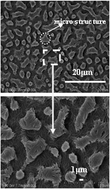Design of super-hydrophobic microporous polytetrafluoroethylene membranes
Abstract
Polytetrafluoroethylene (PTFE) membranes with unique structures were fabricated from a mixture of a PTFE emulsion and a poly(vinyl alcohol) (PVA) aqueous solution. The formation of the micro–nano structures in the PTFE membrane was ascribed to PTFE


 Please wait while we load your content...
Please wait while we load your content...